NWEA MAP Test 2nd Grade: Free Practice, Scores & Prep Tips
Welcome to your comprehensive preparation resource for the NWEA MAP Growth Test for 2nd Grade.
In this guide, you’ll find everything you need to help your child prepare effectively for their upcoming test, including:
- In-depth overview with important things to know
- Free practice test
- Scores interpretation
- Recommendations for accurate practice tests
- And more…
So if you want to maximize your child’s MAP score potential, you’ll love this guide.
Let’s get started!
What’s on This Page
What Is on the 2nd Grade MAP Test?
The Measures of Academic Progress (MAP) test for 2nd graders covers key areas such as mathematics, language usage, and reading. It’s designed to be a comprehensive assessment tool that provides valuable insights into your child’s academic growth over time.
This standardized test isn’t just about evaluating what your child knows; it’s also about measuring how much they’ve learned since the beginning of the school year. The MAP test adapts to your child’s performance, offering a tailored set of questions to gauge their skills accurately. This adaptability allows the test to be both challenging and supportive, ensuring a fair assessment of your child’s abilities.
What Is the Purpose of the MAP Test for Grade 2?
The primary purpose of the MAP test for 2nd grade is to provide educators and parents with a detailed understanding of a child’s academic progress. Unlike traditional standardized tests focusing on one-time performance, the MAP test is a dynamic tool aiming to capture growth over time.
Dive Into the MAP Test 2nd Grade Sections
The MAP test for 2nd Grade is untimed and includes three test sections:
Math Test Section
The math section of the 2nd grade MAP Growth test is a dynamic experience for your 2nd grader, comprising 40-43 questions that cover a spectrum of mathematical concepts. The test includes a mix of word problems, numerical exercises, and visual displays, each demanding a unique approach to problem-solving. Be prepared for various question formats, including selecting items on the screen and providing short answers.
The questions in this section explore different mathematical realms, ensuring a comprehensive assessment of your child’s skills. Here’s a breakdown of the key topics they’ll encounter:
Algebraic Thinking: This involves tasks like representing numbers, solving problems, and analyzing patterns.
Numbers and Operations: Counting, sets, place value, base ten, and fractions take center stage in this category. Your child will demonstrate their proficiency in fundamental numerical concepts, from counting to understanding the significance of place value.
Geometry and Measurement: Shapes and their properties, along with measuring the length of sides using rulers and protractors, form the core of this segment.
Data: The data component involves reading and analyzing information presented in charts. This skill is essential for your child to interpret and draw conclusions from graphical representations of information.
Reading Test Section
The reading section of the 2nd grade MAP Growth test evaluates your child’s proficiency in both literary and informational passages, challenging them with 40-43 questions. Expect a variety of question formats, primarily multiple-choice, with some passages presenting multiple questions for a more comprehensive assessment of reading comprehension.
In this section, your child will delve into various concepts related to both literary and informational content. Here’s a breakdown of what they’ll encounter:
Content: This dimension involves identifying main ideas, locating information, drawing inferences, and summarizing. Your child will be tested on the following aspects:
Literary:
- Characters
- Setting
- Plot
Informational:
- Fact and opinion
- Following directions
- Data and visuals
Craft: Crafting a nuanced understanding of the author’s purpose, writing style, point of view, structure, and genre is the focus of this part of the test. Your child will see the following elements:
- Literary devices
- Informational arguments
Word Meaning: Enhancing vocabulary skills, this component involves understanding word meanings through roots and affixes, context clues, synonyms, and antonyms.
Enhance your child’s reading abilities with 6 MAP reading practice tests for 2nd Grade.
Language Usage Test Section
The Language Usage segment of the MAP Growth test zeroes in on the adept use of the English language, evaluating your 2nd grader’s skills with 40-43 questions. Prepare for various tasks, from identifying and fixing mistakes to completing sentences with missing components. This section has various question formats such as multiple-choice, word fill-ins, and rearranging items on the screen.
In this Language Arts test, your child will be tested on distinct areas, covering a broad spectrum of language proficiency:
Mechanics: This dimension delves into punctuation, capital letters, and spelling. Your child will showcase their grasp of the foundational elements that contribute to clear and accurate written communication.
Parts of Speech: Understanding the nuances of different types of words and their appropriate usage is central to this area. Your child will demonstrate their knowledge of where and how to use words, including tense considerations.
Usage: Crafting sentences with proper grammar and structure is the focus here. Your child will exhibit their ability to construct meaningful sentences, ensuring a solid foundation in the rules of language usage.
Writing Process: A crucial aspect of this test involves navigating the writing process. Your child will not only form meaningful bodies of writing for specific purposes but also identify different types of writing and their relevant characteristics and techniques.
Sharpen your child’s language usage skills with 6 MAP language usage practice tests for 2nd Grade.
How to Prepare Your Child for the MAP Growth Test?
Preparing for the MAP Growth Test can significantly contribute to your child’s success. Here’s how you can support your child’s preparation journey.
Sample Tests & Sample Questions
To gain familiarity with the format and types of questions on the MAP Growth Test, consider incorporating sample tests and questions into your child’s study routine. These resources serve as valuable tools to demystify the test structure and help your child become comfortable with the testing questions.
Encourage your child to take a variety of sample questions that mirror the diversity of topics covered in the actual test. This hands-on approach allows them to practice applying their knowledge and skills to real-world scenarios. As they tackle different question types, they’ll build confidence and develop effective strategies for approaching various challenges.
Below, you’ll find 9 sample questions divided into three difficulty levels.
Full-length MAP Practice Tests
For a more immersive and realistic preparation experience, taking full-length MAP practice tests is key. These comprehensive assessments replicate the conditions of the actual test, providing your child with a deeper understanding of the testing duration, question distribution, and overall test-taking experience.
While preparing, consider integrating these accurate practice tests into your child’s study plan. These resources are designed to align closely with the MAP Growth Test, offering a reliable benchmark for your child’s progress. The nuances and details captured in these practice tests can contribute significantly to their preparedness, without overwhelming them with excessive pressure.
Remember, the goal is not only to familiarize your child with the test format but also to instill a sense of confidence and readiness. By incorporating sample tests and full-length practice tests into their routine, you’re providing them with the tools they need to approach the MAP Test with assurance and competence.
Take a Free MAP 2nd Grade Practice Test
The following sample test includes three test sections, which are further divided into three difficulty levels: easy (slightly below grade level), moderate (grade level), and difficult (above grade level. This will enable you to see where your child struggles and estimate their level.
Math
Easy Question
A digital clock shows the following time:

Which of the following analog clocks show the same time?
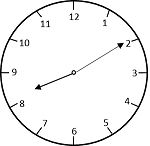
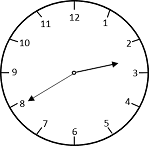
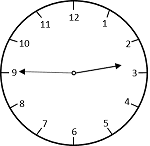
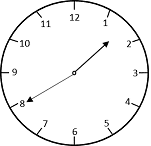
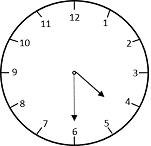
Correct Answer & Explanation:
The digital clock shows the hour 14:40, which is equivalent to 2:40 p.m. = 2 hours and 40 minutes.
First, look for an analog clock in which the hour’s hand points between 2 and 3. The second and third answers have an hour hand pointing between 2 and 3. Thus, you can eliminate the first, fourth, and fifth answer choices.
Next, check the third answer choice: Start counting by five minutes until you get to the minute’s hand.
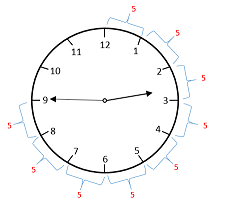
There are nine intervals of five minutes up to the minute’s hand:
9 intervals × 5 minutes = 45 minutes.
Thus, the time in the third answer choice is 2:45 p.m. = 14:45. This is not the same time as on the digital clock (14:40). Thus, this answer choice can be eliminated.
Check the second answer choice: Start counting by five minutes until you get to the minute’s hand.
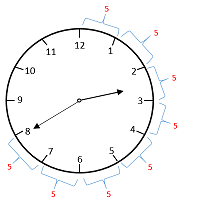
There are eight intervals of five minutes up to the minute’s hand:
8 intervals × 5 minutes = 40 minutes.
Thus, the time in the second answer choice is 2:40 p.m. = 14:40. This is the same time as on the digital clock (14:40).
Therefore, the correct answer is the second one.
Moderate Question
The big square below has been divided into unit squares (squares of one length). What is the area of the big square?
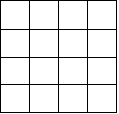
A. 10 square units
B. 12 square units
C. 16 square units
D. 20 square units
Correct Answer & Explanation:
The correct answer is (C).
The area of a square equals the length of its side multiplied by itself. Another way of calculating the area of a shape is by dividing it into unit squares and simply counting the squares (this is why you measure it in square units).
The reason for this is that any unit square has an area equal to one, and adding them up (which is equivalent to counting the squares) is exactly the area of the square.
Each row has four unit-squares, and there are four rows.
Therefore, the total number of unit squares (and the area) is 4 x 4 = 16 square units.
Difficult Question
The graph below shows the results of the latest vote on which subject children like to study the most in school.
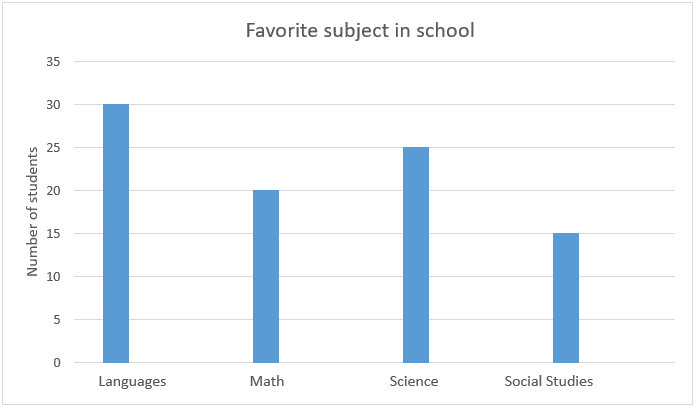
How many children participated in the poll?
A. 80
B. 85
C. 90
D. 95
E. 100
Correct Answer & Explanation:
The correct answer is (C).
To know the number of students that voted for each subject, look at the bars and determine their height. You can see in the graph that the height determines the number of students that voted for that subject.
The data to be drawn from the graph is:
- 30 students voted for Languages as their favorite subject.
- 20 students voted for Math as their favorite subject.
- 25 students voted for Science as their favorite subject.
- 15 students voted for Social Studies as their favorite subject.
Add them up, and the result is the number of students involved in the poll. First, you add up the numbers in the ones column. 0 + 0 + 5 + 5 = 10, so you write down the zero and regroup. Finally, 3 + 2 + 2 + 1 = 8, and then add up the one you had after regrouping to get 9.
Get 6 additional MAP math practice tests for 2nd Grade + math enrichment practice questions.
Reading
Easy Question
What is a dictionary used for?
A. to find synonyms for words
B. to find the meaning of words
C. to learn about a subject
D. to find interesting articles
Correct Answer & Explanation:
The correct answer is (B).
A dictionary gives the meanings of words. The words are listed in alphabetical order. Sometimes, a dictionary includes word forms, pronunciations, uses, and origins of words, as well.
Answer (A) is incorrect because although a dictionary may contain some synonyms as a part of the word definitions, to find a long list of synonyms you need to use a thesaurus.
Answer (C) is incorrect because a dictionary does not contain enough information about subjects to allow you to learn about them.
Answer (D) is incorrect because a dictionary does not contain articles.
Moderate Question
Read the sentences.
Sophia was standing alone in the corner of the classroom. She looked around at her classmates playing games and talking to each other excitedly. She was too shy to join the nice group of girls across the room. She just wished someone would come over and talk to her.
What does the author want you to think about Sophia?
A. She is bored.
B. She is tired.
C. She is friendly
D. She is lonely.
Correct Answer & Explanation:
The correct answer is (D).
The author describes Sophia as standing alone, hesitating whether to join her classmates or not. She simply wants someone from her class to come and talk to her. You can infer that Sophia is lonely.
Answer (A) is incorrect because Sophia clearly shows interest and not boredom when looking around.
Answer (B) is incorrect because none of the sentences point to Sophia being tired.
Answer (C) is incorrect because even though Sophia is interested in some company, she is mostly described as being shy, which is somewhat the opposite of being friendly.
Difficult Question
Read the passage.
Maid [in the doorway]: A lady to see you, ma’am, a stranger.
Nora: Ask her to come in.
This passage is an example of which type of text?
A. a play
B. a story
C. a poem
D. a memoir
Correct Answer & Explanation:
The correct answer is (A).
Answer (A) is the correct answer because a play is a form of literature usually consisting of dialogue between characters. It is intended for theatrical performance rather than just reading, which is why there are usually added stage directions and descriptions in brackets.
Answers (B), (C), and (D) are incorrect because none of these types of text fit the structure of this passage.
Get 6 additional MAP reading practice tests for 2nd Grade to improve your child’s abilities.
Language Usage
Easy Question
Which is a complete sentence?
A. I with my parents to the zoo.
B. The zoo.
C. There were a lot of.
D. I went to the zoo.
Correct Answer & Explanation:
The correct answer is (D).
A complete sentence contains a subject and a predicate.
The subject describes who or what is doing something. The subject is a noun (e.g., flower) or a pronoun (e.g., they).
The predicate describes what the subject is doing. The predicate is usually a verb (e.g., swam) or an adjective.
The only answer that contains both a subject and a predicate (I, went) is answer (D).
Answers (A) and (B) are incorrect because they do not contain predicates.
Answer (C) is incorrect because it does not contain a subject.
Moderate Question
Which is the past tense of the verb “pay”?
A. pay
B. payed
C. paid
D. paied
Correct Answer & Explanation:
The correct answer is (C).
Pay is an irregular verb. Irregular verbs do not become plural by taking on -d or -ed at the end, like regular verbs. Instead, irregular verbs receive other endings, which change from verb to verb. The past tense of “pay” is “paid.”
Difficult Question
Jennifer is writing a paper about junk food and why children should not consume much of it.
Which writing genre is appropriate for Jennifer’s purpose?
A. Descriptive writing
B. Poetry writing
C. Narrative writing
D. Persuasive writing
Correct Answer & Explanation:
The correct answer is (D).
Jennifer’s purpose is to write a paper that will persuade the reader that kids should not eat junk food. Persuasion means winning someone to your viewpoint or cause. Therefore, the correct answer is persuasive writing.
Answer (A) is incorrect because the main purpose of descriptive writing is to describe a person, place, or thing in a way that a picture is formed in the reader’s mind. Generally, it is not used for persuasion.
Answer (B) is incorrect because in poetry writing you create poems using rhymes and other stylistic tools and your purpose is not necessarily to persuade the readers.
Answer (C) is incorrect because narrative writing is a type of writing that tells a story and which is usually categorized as fiction. Generally, it is not used for persuasion.
Get Accurate MAP Test Practice Resources to Maximize Your Child’s Score
Get an additional 460+ practice questions that resemble the actual MAP 2nd Grade test to maximize your child’s chances of scoring high.
The questions are divided into 18 skill-focused practice drills and 3 full-length tests that simulate the actual exam. Also, each practice question comes with an easy-to-follow explanation so your child can understand how to answer each question and learn from their mistakes.
In addition, you receive math enrichment practice questions and an interactive math game to further improve your child’s numerical skills.
Get the comprehensive MAP 2nd Grade practice (460+ questions, enrichment drills, games) on this page.
MAP K-2 vs the Standard MAP Test: Choosing the Right Fit for Your Child
When it comes to the MAP assessment for 2nd graders, the NWEA offers two versions, each tailored to different learning needs. Let’s explore the options so you can make an informed decision about which test is the best fit for your child.
The first option is the MAP K-2, designed for kindergarteners, 1st graders, and 2nd graders who may not feel completely at ease with reading. This version caters to early learners by using recorded instructions instead of written ones.
It goes a step further by incorporating recorded answer choices and pictures, reducing the reliance on text comprehension. This design ensures that the test accurately assesses the students’ skills without potential misunderstandings related to reading.
On the other hand, there’s the standard MAP test with written instructions. If your 2nd grader is comfortable comprehending questions and answers without audio assistance, this might be the preferred version.
It follows the same format used from 2nd grade through 5th grade for math and continues through 12th grade for other subjects.
While both versions adapt to your child’s level, the standard test provides more room for growth, preparing students effectively for future MAP assessments.
Consider reaching out to your school to find out which version they plan to administer to your child. If the decision is in your hands, weigh the options based on your child’s comfort and proficiency.
This way, you can make a choice that aligns with their learning style and sets the stage for success in future MAP assessments.
No matter which option you choose, we got you covered with tailored and comprehensive practice resources:
– MAP 2nd Grade Practice Tests
– MAP K-2 Practice Tests
Understand What the 2nd Grade MAP Test Scores Mean
When it comes to analyzing your child’s performance on the 2nd Grade MAP Test, it’s crucial to grasp the significance behind the scores, including RIT scores and RIT percentiles. Let’s delve into the details.
RIT Scores
NWEA calculates MAP assessment scores using the RIT scale, comparing a student’s performance to their past scores. Each RIT score represents a point on a continuous learning scale, serving as a benchmark for a student’s academic skill level over time.
Derived from thousands of students nationwide, these scores are not specific target values but provide insights into a student’s educational progress.
RIT Percentiles
Adding another layer to the assessment, RIT percentiles provide a comparative analysis. These percentiles indicate where your child’s performance stands relative to other 2nd graders nationwide. For instance, a 65th percentile means your child scored higher than 65% of students in the same grade. This contextualizes their achievement in a broader academic landscape.
How to Interpret the Scores
Interpreting the scores involves considering both RIT scores and percentiles. A score above the average range for 2nd grade, coupled with a high percentile, is generally indicative of strong performance. It’s essential to recognize that the MAP Test emphasizes growth over time. Hence, improvement from previous assessments is a positive sign.
See the following table for specific RIT scores and percentiles for 2nd grade (based on this official document):
| Mathematics | Language Usage | Reading | Percentile | |
|---|---|---|---|---|
| Higher Achievement | 196 | 200 | 197 | 95 |
| 188 | 190 | 187 | 84 | |
| 181 | 182 | 180 | 69 | |
| Median and Mean | 175 | 174 | 172 | 50 |
| Lower Achievement | 169 | 166 | 165 | 31 |
| 162 | 158 | 157 | 16 | |
| 154 | 148 | 147 | 5 |
What is a Good NWEA MAP Test Score for 2nd Grade?
When it comes to determining a good NWEA MAP Test score for 2nd grade, aim for a RIT score above the average range for 2nd graders. Additionally, a high percentile, preferably above 70%, indicates that your child performed well compared to their peers nationwide.
Can You Retake the MAP Test for 2nd Grade?
While the MAP test is not designed for frequent retakes, there are circumstances where a retake may be considered. If these circumstances include illness or other factors affecting performance, your child’s school may consider a retake on a case-by-case basis.
11 Fun & Actionable Tips for Preparing Your Child for the Second Grade MAP Test
Turn Everyday Activities into Learning Moments
Transform routine activities into playful learning opportunities. For example, during grocery shopping, have your child identify shapes and count items. This not only reinforces basic math skills but also makes learning a part of their everyday experiences.
Storytime with a Twist
Enhance reading comprehension in a fun way by adding a twist to your usual storytime routine. Choose a book and afterward, ask your child to create an alternate ending or imagine a new adventure for the characters. This fosters creativity and critical thinking, essential skills for the MAP test.
Math in the Kitchen
Bring math to life in the kitchen! While cooking or baking, involve your child in measuring ingredients, doubling or halving recipes, and discussing the importance of fractions. This hands-on approach makes math concepts more tangible and enjoyable.
Explore Nature’s Classroom
Take learning outdoors by exploring nature. Turn a simple walk into a scavenger hunt, encouraging your child to observe and identify different plants, animals, or even cloud shapes. This not only refreshes their mind but also enhances observational skills, which are beneficial for the MAP test.
Encourage Reading Diversity
Expand your child’s reading horizons by introducing a diverse range of materials. Include fiction, non-fiction, and informational texts to enhance their comprehension skills across various genres. This broad exposure not only enriches their vocabulary but also prepares them for the diverse content of the MAP test.
Create a Personalized Study Space
Set up a cozy and inviting study space for your child. Allow them to decorate it with colorful posters or motivational quotes. Having a designated space can make studying feel special and help them concentrate better.
Educational Games Night
Turn study sessions into a game night. Choose educational board games or card games that reinforce math, language, or general knowledge skills. This not only makes learning enjoyable but also encourages healthy competition.
Role Reversal Learning
Let your child take on the role of the teacher. Ask them to explain a concept or solve a problem as if they were the instructor. This not only reinforces their understanding but also boosts their confidence in articulating ideas.
Mindful Relaxation Techniques
Incorporate mindfulness and relaxation techniques into your preparation routine. Teach your child simple deep-breathing exercises or short meditation sessions to alleviate test-related stress and promote a positive mindset.
Embrace Practice Tests
Utilize practice tests as a fundamental part of your preparation routine. Regularly expose your child to sample questions and full-length practice tests to familiarize them with the test format and build confidence. Analyze their performance together, addressing areas that may need extra attention. This structured approach ensures they become comfortable with the testing environment.
Establish Consistent Study Habits
Encourage consistency in study habits to create a sense of routine and discipline. Set aside specific times each day for focused study sessions, balancing learning with breaks. Consistent practice helps your child develop a study routine, reinforcing the importance of preparation and self-discipline for academic success.
How’s the MAP Test Grade 2 Related to the Common Core
The Common Core State Standards (CCSS) serve as a national guideline, describing what students should know and be able to do at each grade level in English language arts and mathematics.
The MAP Test for 2nd Grade aligns closely with these standards, acting as a tool to measure a student’s progress and proficiency in areas outlined by the Common Core.
For English language arts, the test assesses reading comprehension, language usage, and writing skills, ensuring alignment with CCSS expectations. In mathematics, the MAP Test delves into essential topics such as number sense, algebraic thinking, and geometry, in harmony with the Common Core’s mathematical standards for 2nd grade.
Conclusion
This article has provided comprehensive insights into each of the MAP test aspects, offering you a roadmap to support your child’s success. As you embark on this journey, remember that preparation is not only about test familiarity but also about fostering a love for learning and growth. Utilizing accurate practice resources, choosing the right test fit, and incorporating fun and actionable tips create a well-rounded strategy for a positive MAP testing experience. Good Luck!
